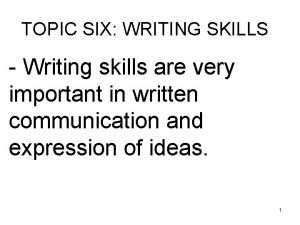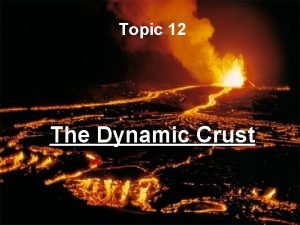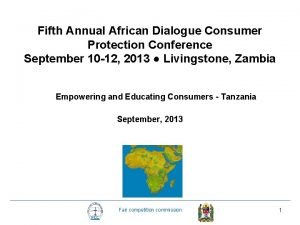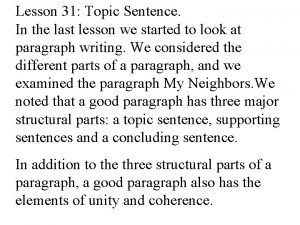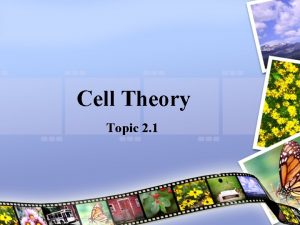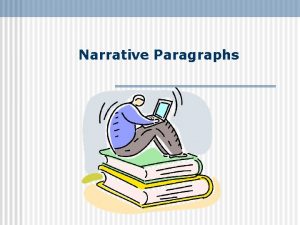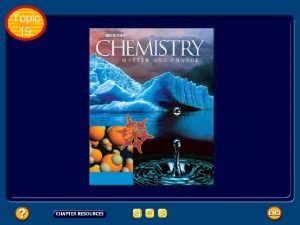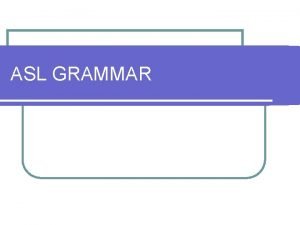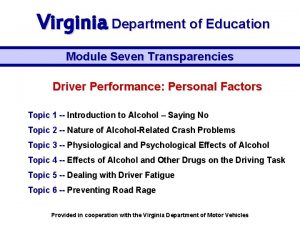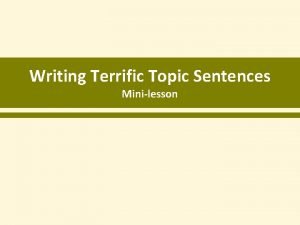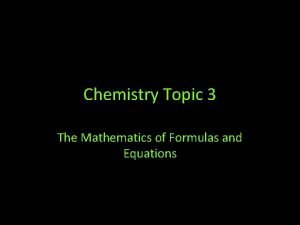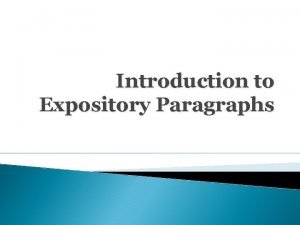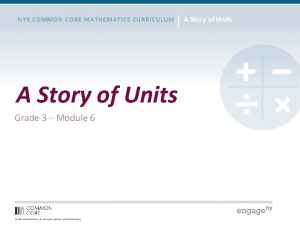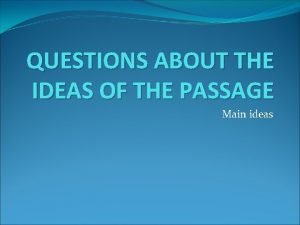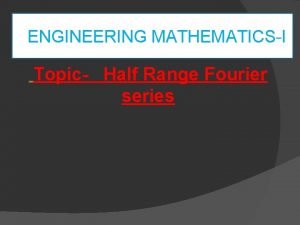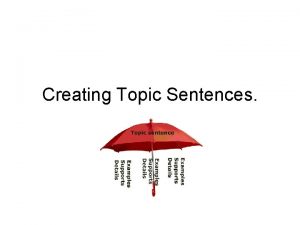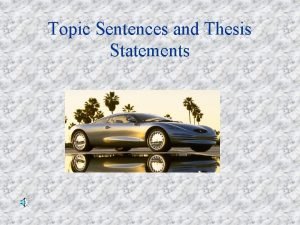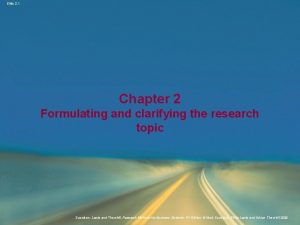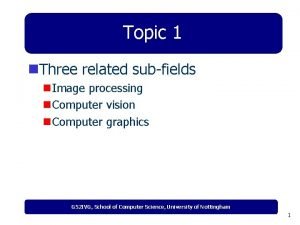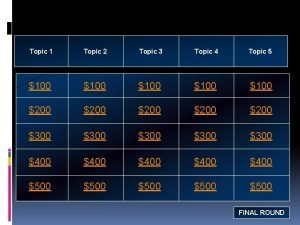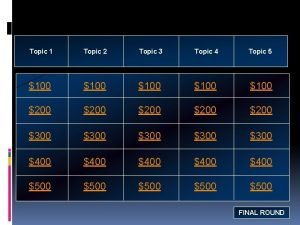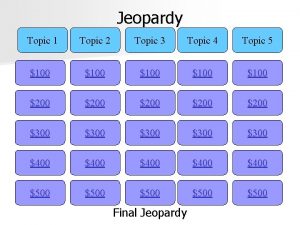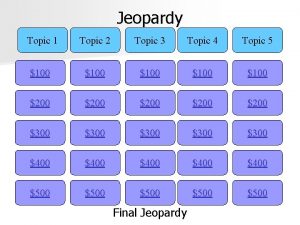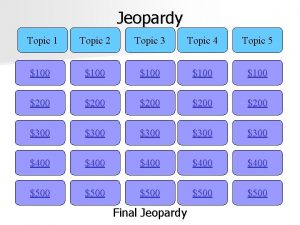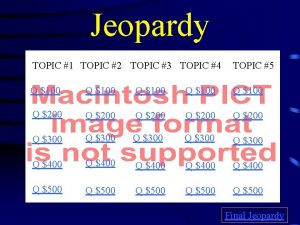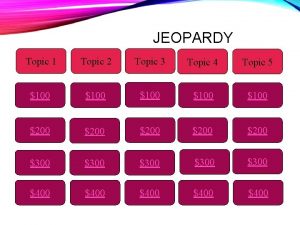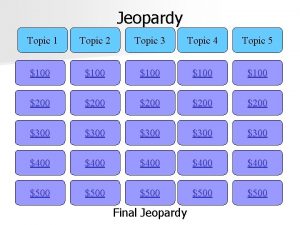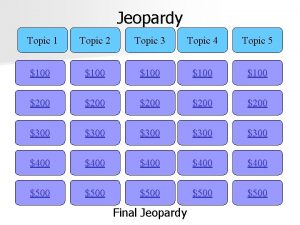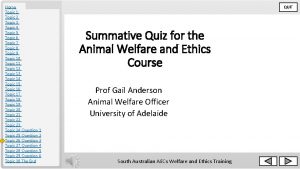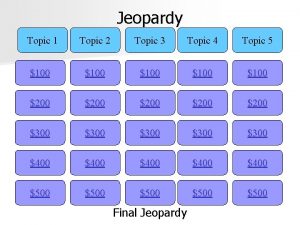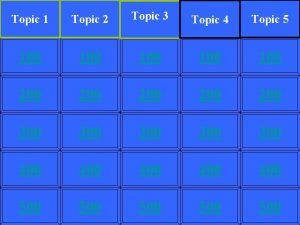Respiration Topic 8 1 Respiration n In respiration





























- Slides: 29

Respiration Topic 8. 1

Respiration n In respiration, energy stored in _______ molecules is transferred to ________ (ATP) ATP is used to run various ________ in the cell Synthesizing ATP uses a series of _____ and ______ reactions • Energy lost from the _______ of food molecules can be absorbed by the reduction reaction to _____

Glycolysis n n Is the first step of all types of _________ Happens in the _____ of all cells A 6 carbon molecule of _____ is oxidized into 2, 3 carbon ______ molecules coupled with the reduction of _____ to ATP Broken into several steps

Glycolysis cont. Phosphorylation n First stage begins by ________ glucose into a hexose diphosphate n This step actually _____ n The phosphate groups that are added allow a ______________ between the hexose and its _____

Glycolysis cont. Lysis n Hexose diphosphate is broken down into two _______ molecules n These are ________ molecules in many biochemical _______ n The ________ on each of the triose phosphates allows a ________ with the next enzyme in the pathway

Glycolysis cont. Oxidation and ATP formation n Each triose phosphate (TP) is ______ to a 3 carbon molecule called ______ n Each TP has a ____ removed to reduce a ______ into a ______ n Each TP also uses the energy in its _______ to phosphorylate 2 ADP into ATP (total of 4 ATP made minus 2 used at beginning for net of 2) n Called _________________

Substrate level phosphorylation n n When ATP is produced by a _______ of a phosphate group from a substrate molecule to an _____ This is in contrast to ___________

Mitochondria n n n _______ – fluid inside the mitochondria that contains enzymes for _____ and ________ – separates contents from rest of cell and creates a compartment for _________ – contains the __________ and ATP synthase, which carry out ____________

n n _____ – tubular projections of the inner membrane which ________ for oxidative phosphorylation- the creation of _____ Space between the inner and outer membranes_____ are ____ into it by the electron transport chain. Because of the small space a high concentration is formed for ______

Aerobic Respiration is the production of ATP in the presence of ______in the _______ Link Reaction n Pyruvate made in _____ is _______by the mitochondria n Enzymes in the matrix remove _____ from the _______ (oxidation) n Other enzymes remove a _____ from 3 C-pyruvate (_________)

Link reaction cont. n n n These two steps together are called ___________ Hydrogen is accepted by _______ (reduced) to _______ that is removed becomes _____ Remaining _____ molecule is acetly group which reacts with Co-enzyme A to become _____ Acetyl Co. A is the ______ of the Krebs cycle

Krebs cycle

Krebs Cycle cont. The product of the link reaction (_____) joins the Krebs cycle which takes place in the _____. 1. Acetyl Co. A joins a _____ compound already in the cycle to form a 6 C molecule (_______). - Coenzyme A is released to go and bring more _____ into the matrix n

Krebs Cycle cont. 2. 6 C compound (citric acid) is ______________ to a 5 C compound - this carbon is given off as _____ - NAD+ is _______ to NADH + H

Krebs Cycle cont. 3. The 5 C compound is ________ and ______ to make a 4 C compound - again C is given off as CO 2 - again a NAD+ is reduced to NADH+H

Krebs Cycle cont. 4. The remaining steps are the _________ of the 4 C acceptor molecule that will combine with acetly Co. A at the beginning of the _______ - final reduction of an NAD+ to NADH+H - Reduction of a FAD (coenzyme) to FADH 2 - ADP reduced to an ATP by _____________

Krebs Cycle Summary One turn of the Krebs Cycle yields n n n (by subtrate level phos. ) -Everything above is X 2 because there are two molecules of _____ from every molecule of ______ - NADH+H and FADH 2 will feed into the electron transport chain to make the ________ n

Electron Transport Chain aka Oxidative Phosphorylation The ETC is a series of electron carriers located in the inner mitochondrial membrane 1. Electron carrying molecules (NADH+H, FADH 2) produced in the Krebs cycle move from the matrix to the inner membrane. n

Electron Transport Chain aka Oxidative Phosphorylation cont. 2. NADH+H and FADH 2 are oxidized (lose electrons) and the H ions with attached electrons enter the ETC where they reduce (add electrons) a series of reactions.

Electron Transport Chain aka Oxidative Phosphorylation cont. 3. Some of these reactions separate the H from their electrons. H ions then leave the ETC and enter the inter membrane space 4. The high concentration of H+ ions is used by ATP synthase during chemiosmosis to produce ATP

ATP synthesis during Chemiosmosis n n As the H+ ions diffuse from the inter-membrane space back to the matrix, ATP synthase uses this force to turn its pumps which phosphorylates ADP to ATP The coupling of the oxidation reactions in the ETC and mechanism of ATP synthase phosphorylating ATP is oxidative phosphorylation

Role of Oxygen in Respiration n n Oxygen is the final electron acceptor at the end of the electron transport chain At the same time it accepts H ions in the matrix to form water (waste product) If O 2 is not available, electrons will stop flowing thru ETC NADH +H cannot be converted to NAD+ and the link reaction cannot take place for aerobic respiration

Electron Transport Chain aka Oxidative Phosphorylation

Structure vs. Function in Mitochondria Structure n Folded inner membrane forming cristae n Small space between double membranes Function n Increases surface area for the electron transfer system n Allows accumulation of protons n n Matrix Liquid filled for concentration and traveling of enzymes to complete the reactions of the Krebs cycle

Structure and Function cont. n n Electron micrographs of muscle cells can show adaptions to aerobic respiration Increased number of Mitochondria

Acetyl Co. A in Metabolism n n Acetyl Co. A is the start molecule of the Krebs cycle Carbohydrates are broken down into pyruvate and pyruvate is converted to Acetyl Co. A Fats are broken down into glycerol and fatty acids Fatty acids are broken into 2 C fragments that are oxidized into Acetyl Co. A

OIL - RIG n OIL – oxidation is loss n RIG – reduction is gain

Oxidation n A. B. C. Typically has a loss of energy Has a loss of electrons which increases charge A lot of times facilitated by the gain of oxygen Also facilitated by the loss of a hydrogen

Reduction n A. B. C. Typically has a gain of energy Has a gain of electrons which reduces charge A lot of times associated with the loss of an oxygen Also associated by gain of hydrogen
 Pee writing strategy
Pee writing strategy Narrow down the topic
Narrow down the topic Internal respiration vs external respiration
Internal respiration vs external respiration External respiration
External respiration Topic six
Topic six Ccea topic tracker
Ccea topic tracker Topic 12 earth's dynamic crust and interior
Topic 12 earth's dynamic crust and interior What is consumer awareness
What is consumer awareness The last lesson
The last lesson Prompt topic
Prompt topic Topic 2 assessment
Topic 2 assessment Implied or stated
Implied or stated Specific purpose statement
Specific purpose statement Narrative paragraph form
Narrative paragraph form Look at these pictures and answer the questions
Look at these pictures and answer the questions Which equation represents an oxidation-reduction reaction
Which equation represents an oxidation-reduction reaction Asl closing signal
Asl closing signal Drivers ed module 7
Drivers ed module 7 Topic statement
Topic statement Topic 3 the mathematics of formulas and equations
Topic 3 the mathematics of formulas and equations Example of topic
Example of topic Topic b
Topic b Topic 4 the renaissance and reformation
Topic 4 the renaissance and reformation “what is the main idea of the passage”
“what is the main idea of the passage” What is a supporting sentence
What is a supporting sentence Half range fourier series
Half range fourier series Whats topic sentence
Whats topic sentence Two parts of topic sentence
Two parts of topic sentence Formulating and clarifying the research topic
Formulating and clarifying the research topic Topic 1 image
Topic 1 image




